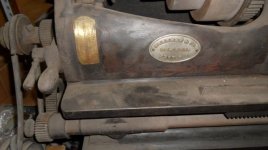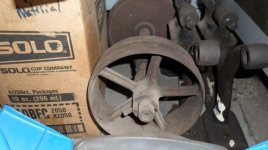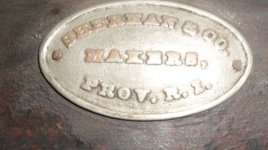The reason is that I bought it and picked it up on Dec. 4th and I would really like to know what I have.
Oh goody! Glad for the lathe AND for you.
The lathe is a bit old and rare. More on this later.
Alas, I really can't tell you much about your lathe, or more particularly the maker. I suspect Sherman was one of the MANY who set themselves up in business during that halcyon period of American free enterprise - and didn't survive. But maybe not for reason of ability. What I've seen of the lathe in pix it looks like a typical lathe of the Civil War period. This was about the end of the age of craftsmanship. After the Civil War the Industrial Era began for the United States and along with this came parts interchangability and design tolerence. Despite being a "one off" and a transition machine, your lathe is probably pretty well made and quite functional - considering it's natural developmental shortcomings. Machinery HAS improved in 150 years.
One of these shortcomings typically is change gears. Most lathes of this period are frequently found today with 13 change gears to make the typical UNC threads we now use. My circa 1860 lathe actually has about 25 gears, and of these perhaps 4 are repeats (same number of teeth on the gear this for reason to set up a compound train in various permutations) But a lathe of the 1860s was required to make almost ANY thread per inch the machine designer required, this because threads were not so much standardized. You can play around with your 18 gears after reading about change gear calculations and see what you have available. Or there may be a plate on the lathe indicating all this - no calculation required.
Another is the act of using the lathe for threading. In the 1860s threading was done by connecting the carriage to the lead screw and LEAVING IT CONNECTED. No thread dials. The entire lathe countershaft and everything would be run to cut the thread, and then EVERYTHING would be run backwards using the reverse lever on the countershaft to "unwind" the tool position to the start for another cut. This threading action takes more time - but in the 1860s, time-motion studies hadn't even been thought of yet. You probably see a swing-away "stop" that can be set to allow reset of the tool at each pass of the thread. This the precursor to a compound rest - which had been developed but not generally applied to general purpose lathes.
Another is that this lathe will cut slower than a more modern machine. In 1860 most tool steel came to the US from overseas, mostly from the glass making regions of England. English tool steel was expensive, and only slightly harder than the steel or cast iron that one might be cutting on the lathe. A lathe operator might also be hand forging the tool to his purpose and drawing the temper afterwards. I have a set of 11 hand forged tools that came with my lathe each amounting to a piece of tool steel up to 10 inches long and of section 5/8 x 1-1/2". Those 11 tools probably cost the original owner nearly the price of the lathe itself.
Sandpaper and abrasives were not in plentiful supply either. So machined surface finish was of BIG interest. This lathe likely somewhat "adjustable" on the fly both on carriage feed rate (by hopping the belt on the drive feed shaft) and on tool height/position relative to the cut. A cut would be started, and if found to be "snaggy" or otherwise unacceptable on surface finish, the lathe would be "tweaked" while in motion to improve the action. (This was the BIG improvement that Thayer & Houghton brought to the lathe world in 1853 at the Worcester Mechanics Association Annual Show - and what impressed everyone beyond the styling of their lathes.)
Thus a lathe of this ilk tends to depend a lot on the skill of the operator. Modern high speed tooling and toolholders tend to remove SOME of this skill and certainly the cost, but not all.
As to a restoration, I guess I would advocate the middle road. Do what you need to clean up this lathe and make it presentable: make this lathe work, but no more.
NOT a big fan of sandblasting. Use electrolytic methods if those methods are required.
The museum quality restorations are nice - and show us exactly what we today think the machinery looked like at the time it was made - but a lot of this is conjecture and transferrence of our ideas of what is "right." We are the products of our age and not the products of 150 years ago. What we think of as a presentable painted surface might then have been considered superfluous. And visa-versa. Also paint today is a LOT more uniform and glossy than in those days. The premium glossy paint of the 1860s was Japan Black and Chinese Red. Both were imported on clipper ships and VERY expensive and not generally used for common machinery. Today's Rustoleum black from a can is about on par gloss wise with 1860 Japan black. The most commonly used machine paint of the 1860s in any color (and colors varied) was a lot more dull, but not "flat." Somewhere in-between. So what you see in most museums like the Smithsonian is what some museum researcher THINKS is correct. And more than likely he will err on the side of "box-office." Attendance at the museum is augmented when you give the people what they want. But what they want is not necessarily historically accurate. And in the process of "restoration" one loses what was - or is.
You can't go wrong by a middle course. You add yourself to the long line of "users" of this lathe by a middle course. And this lathe was made to be used - IMHO. And you do it no disservice by doing this - or not doing that.
When you get a chance can you put up some more pix of this lathe? We've lost the original Craigslist posting - except for the nameplate I pulled out and attached separately.
This IS quite a find. Probably among the 500 oldest lathes extant in this country. And yours more notable because its NOT of the usual Worcester makers. But probably the maker was trained and worked in the Worcester tradition, but moved to Providence to take advantage of cheaper materials including tool steel?
Good luck. Below my Shepard, Lathe & Co. lathe from 1860.
Joe in NH
 . Take care, Jake
. Take care, Jake
. Take care, Jake






